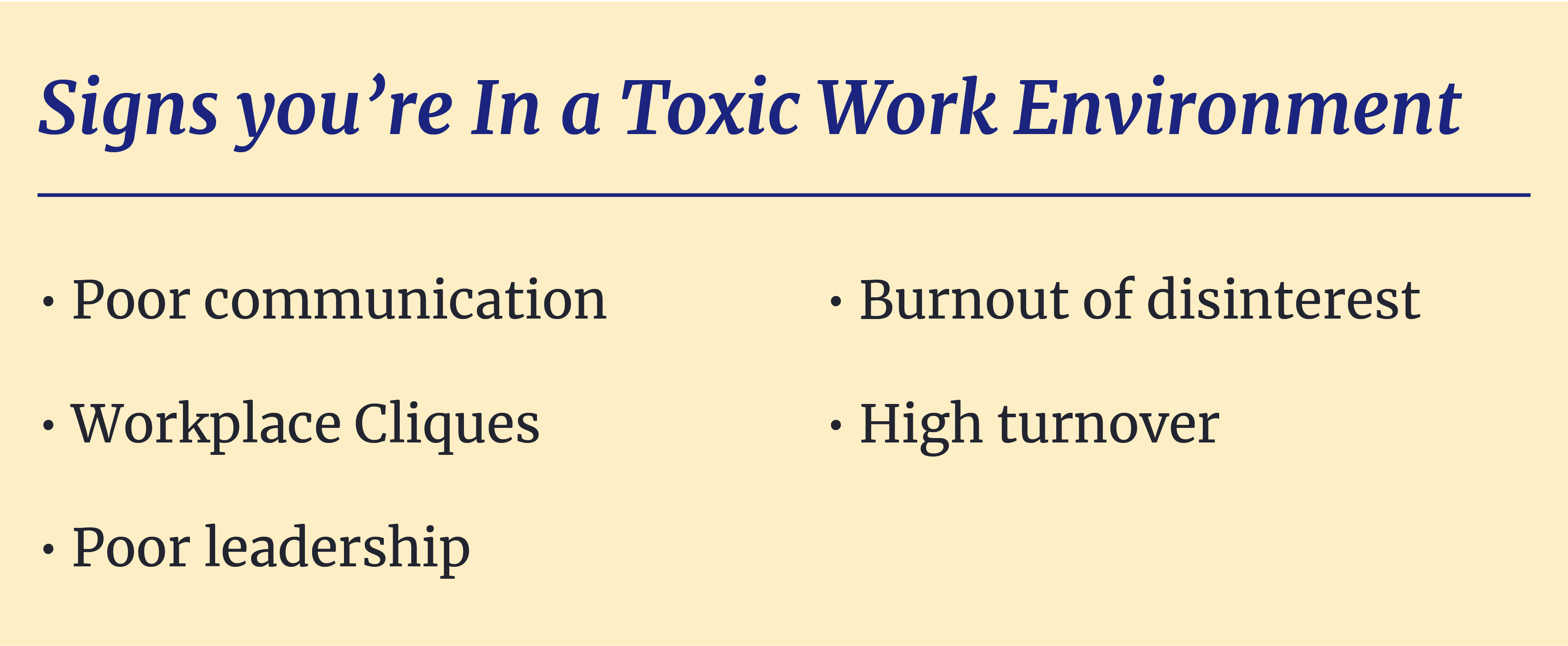Every job has good days and bad days, just like life. Rough patches are common in all workplaces, but these usually smooth out over time. If you’re feeling burned out and can’t seem to snap yourself out of it, it’s time to take a closer look at what’s going on. It’s possible you’re in a toxic work environment.
Signs of a toxic work environment
Toxicity in the workplace could be directed right at you, or it could just be a general workplace culture. Either way, it’s important to look closely at what you’re experiencing and determine what your next step should be. A toxic work environment often includes some or all of the following situations:

Poor communication
Insufficient information, shifting priorities, and unclear direction often lead to a communication breakdown in the workplace. It’s not uncommon to experience poor communication in the workplace during a particular project or with a single co-worker. But if the overall tone of the communication in your workplace is negative, passive-aggressive, or worse, discriminatory, it’s time to make a change.
Workplace cliques
Ideally, we would all play nice with each other in the workplace. Cliques are counterproductive in so many ways. They hinder collaboration, can impact the work you’re offered, and can decrease your opportunities for advancement if you’re not part of the in-crowd. Drama and gossip are common when workplace cliques exist, too, and should be avoided when possible.
Poor leadership
A company’s culture flows from the top down, and negative leadership can impact the overall workplace. Practices like exclusion, blame, and micromanagement creates a cycle of toxicity in the workplace that’s extremely hard to break. Often, a toxic boss behaves the way they do because their boss does, too, and that boss’s boss and so on. Simply moving departments may not be enough to get away from this toxic practice.
Burnout and disinterest
If you’re in a toxic workplace, you might recognize a general lack of motivation in the employees around you. As a result, you may find yourself taking on more and more work to try to accomplish the organization’s goals on your own. You may also feel pressured to avoid taking vacation days or mental health days, even if they’re offered. This pressure can lead to employee burnout.
High employee turnover
Fortunately, this is one sign of a toxic workplace that you may be able to identify before you even join. When researching a company you’re applying to, pay close attention to the tenure of its employees. Take a look at employee profiles on LinkedIn and note how long they spent with the company. If you see a turnover trend, proceed cautiously.
What to do next
If you find yourself in a toxic work environment, you can either change your situation or change your job. First, it’s important to determine what factors you can influence or change, and which factors you can’t. If toxicity is systemic in your company, it may be best to find a new job.
Get More Tools to Deal with a Toxic Work Environment
Sometimes you can shift your perspective, and sometimes you need to call in some help. If you’re in a toxic workplace, here’s how to address it.
When toxicity becomes illegal
Despite the benefits of hiring moms, a negative attitude toward moms in the workplace, or mom bias, is still prevalent. As a mom, this judgment can make a work environment feel extremely toxic.
If you feel that you’re being specifically targeted by toxic practices because you’re a mom, you may have some legal recourse. While your status as a parent isn’t expressly protected under federal law, discrimination against moms is often rooted in discrimination based on sex which is a protected class. If an employer treats all employees poorly, both male and female, you may not be able to prove discrimination.
Dealing with Work Conflicts Remotely
Remote work brings its own communication challenges which can often lead to conflicts. Left unaddressed, these conflicts can lead to a toxic remote work environment. Here’s how to deal with conflicts remotely.
When it’s time to make a change
Sometimes the signs of a toxic work environment are subtle, and individual differences in mental health, priorities, and overall life demands can make a big difference in what feels toxic. What feels toxic to you in your workplace may not feel toxic to another employee. Similarly, what makes another employee uncomfortable may not impact you in the same way. It’s possible, too, that there are things you could do to contribute to a more positive work environment.
If you’ve done all you can do to address the toxic environment in your workplace, it’s important to honor what your gut is telling you - if it feels toxic to you, it’s time to make a change.
Join a community that cares
The Mom Project supports women throughout their working motherhood journey. Search for career opportunities with vetted, family-friendly employers, and get access to job search tools, career development resources and a thriving community of moms and allies. 



